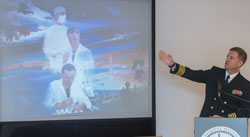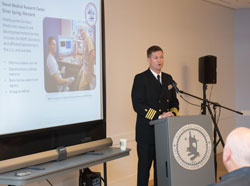Navy Medicine's imprint on global health discussed at recent NMHM Science Café
By: Paul Bello, National Museum of Health and Medicine
SILVER SPRING, Md. – An overview of Navy Medicine in the global community was the topic of conversation Oct. 28, as the National Museum of Health and Medicine (NMHM) welcomed Navy Capt. John W. Sanders M.D., commanding officer of the Naval Medical Research Center (NMRC), to its monthly Medical Museum Science Café at the Silver Spring Civic Building. The two organizations are neighbors at the Fort Detrick/Forest Glen Annex and have partnered together on several projects highlighting advances in the fields of health, science and medicine.
The evening's discussion was two-fold for Sanders, as it allowed him to highlight specific accomplishments in the history of Navy medical research while also providing a glimpse into its future research and development around the globe. He said the mission of Navy medicine is to protect the health and improve medical care for its Sailors and Marines.
There have been several groundbreaking advances as a result of Navy medicine throughout the years. That list includes the work of Navy Commander Robert A. Phillips, a research scientist during World War II whose research led to a cure for cholera. Sanders said it was through Phillip's research that the ability to measure electrolytes and replace fluids appropriately was discovered. This spurred oral rehydration salts that would go on to save millions of people and earn Phillips the Lasker Award, the American version of the Nobel Prize, as well as other numerous awards in medicine.
Sanders also mentioned Harry Hoogstraal - another prominent name associated with naval medical research. An American entomologist and parasitologist, Hoogstraal is regarded as the world's foremost expert on ticks and tick-borne diseases. He would serve as the head of the Department of Medical Zoology for Naval Medical Research at the laboratory in Cairo, Egypt. There are currently more than 200 species derived from Hoogstraal's name, Sanders said.
As for today's evolving enterprise, NMRC is composed of eight commands, five of which are in the U.S. Various directorates fall under these commands ranging from infectious diseases, medical modeling and simulation to submarine wellness and aeromedical research.
Sander's pointed out that NMRC is supporting the Department of Defense's participation in Operation United Assistance with two mobile labs in Liberia. These labs are rapidly deployable detection laboratories incorporating molecular analysis techniques. The lab staff has no direct contact with patients, but they are receiving patient blood samples from the Ebola Treatment Units and health care facilities in order to detect the Ebola virus, Sanders said. The results are later reported to the health care providers. The labs' detection capabilities have reduced the time it takes to determine whether a patient has Ebola from several days to less than 24 hours, but usually within 4 – 7 hours, according to Sanders.
"Having worked for years on infectious diseases and how to control them and identify them, we have some of the world's foremost experts in our enterprise," Sanders said. "Their work is extraordinary and vital on so many levels."
The three overseas labs of NMRC can be found in Egypt, Peru and Singapore. Sanders said its Cairo, Egypt, lab was instrumental in discovering and describing the explosive growth associated with Hepatitis C back in the 1960s.
When asked where he saw NMRC in 10 years, Sanders said medical research would continue wherever U.S. service members are deployed. He also expects joint projects to continue and to have even stronger relationships with colleagues from both the Army and Air Force. As for its overseas labs, he expects to continue working hand-in-hand with personnel from the host countries Ministry of Health, the Centers for Disease Control (CDC) and the National Institutes of Health (NIH), in addition to various public and private partners.
"In recent years, we've partnered with the Gates Foundation, founded by Bill and Melinda Gates, to pursue vaccines in the interest of world health," Sanders said. "We look to partner with private industry and universities to further develop those products."
NMHM's Medical Museum Science Cafés are a regular series of informal talks that connect the mission of the DoD museum with the public. NMHM was founded as the Army Medical Museum in 1862 and moved to its new location in Silver Spring, Md. in 2012.
NMHM's Medical Museum Science Cafés are a regular series of informal talks that connect the mission of the Department of Defense museum with the public. NMHM was founded as the Army Medical Museum in 1862 and moved to its new location in Silver Spring, Md. in 2012. The next Science Café is entitled "Bacteriophage Therapy: Is There an Alternative to Antibiotics?" It will be held Tuesday, Aug. 26 from 6-7 p.m. at the Silver Spring Civic Building. The program is free and open to the public.
 |
Caption: Navy Capt. John W. Sanders M.D., commanding officer of the Naval Medical Research Center, takes a question during the National Museum of Health and Medicine's monthly Medical Museum Science Café, held Oct. 28 at the Silver Spring Civic Building. Sanders provided an overview of Navy medical research and answered questions about the organization's role in providing innovative solutions to health and medical issues around the globe. |
 |
Caption: Navy Capt. John W. Sanders M.D., commanding officer of the Naval Medical Research Center, discusses the history of Navy Medicine during his presentation at the National Museum of Health and Medicine's monthly Medical Museum Science Café, held Oct. 28 at the Silver Spring Civic Building. Sanders provided an overview of Navy medical research and answered questions about the organization's role in providing innovative solutions to health and medical issues around the globe. |
 |
Caption: Navy Capt. John W. Sanders M.D., commanding officer of the Naval Medical Research Center, highlights NMRC's headquarters in Silver Spring, Md. during his presentation at the National Museum of Health and Medicine's monthly Medical Museum Science Café, held Oct. 28 at the Silver Spring Civic Building. Sanders provided an overview of Navy medical research and answered questions about the organization's role in providing innovative solutions to health and medical issues around the globe. |



